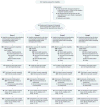The Effect of Nursing Quality Improvement and Mobile Health Interventions on Infant Sleep Practices: A Randomized Clinical Trial
- PMID: 28742913
- PMCID: PMC5593130
- DOI: 10.1001/jama.2017.8982
The Effect of Nursing Quality Improvement and Mobile Health Interventions on Infant Sleep Practices: A Randomized Clinical Trial
Abstract
Importance: Inadequate adherence to recommendations known to reduce the risk of sudden unexpected infant death has contributed to a slowing in the decline of these deaths.
Objective: To assess the effectiveness of 2 interventions separately and combined to promote infant safe sleep practices compared with control interventions.
Design, setting, and participants: Four-group cluster randomized clinical trial of mothers of healthy term newborns who were recruited between March 2015 and May 2016 at 16 US hospitals with more than 100 births annually. Data collection ended in October 2016.
Interventions: All participants were beneficiaries of a nursing quality improvement campaign in infant safe sleep practices (intervention) or breastfeeding (control), and then received a 60-day mobile health program, in which mothers received frequent emails or text messages containing short videos with educational content about infant safe sleep practices (intervention) or breastfeeding (control) and queries about infant care practices.
Main outcomes and measures: The primary outcome was maternal self-reported adherence to 4 infant safe sleep practices of sleep position (supine), sleep location (room sharing without bed sharing), soft bedding use (none), and pacifier use (any); data were collected by maternal survey when the infant was aged 60 to 240 days.
Results: Of the 1600 mothers who were randomized to 1 of 4 groups (400 per group), 1263 completed the survey (78.9%). The mean (SD) maternal age was 28.1 years (5.8 years) and 32.8% of respondents were non-Hispanic white, 32.3% Hispanic, 27.2% non-Hispanic black, and 7.7% other race/ethnicity. The mean (SD) infant age was 11.2 weeks (4.4 weeks) and 51.2% were female. In the adjusted analyses, mothers receiving the safe sleep mobile health intervention had higher prevalence of placing their infants supine compared with mothers receiving the control mobile health intervention (89.1% vs 80.2%, respectively; adjusted risk difference, 8.9% [95% CI, 5.3%-11.7%]), room sharing without bed sharing (82.8% vs 70.4%; adjusted risk difference, 12.4% [95% CI, 9.3%-15.1%]), no soft bedding use (79.4% vs 67.6%; adjusted risk difference, 11.8% [95% CI, 8.1%-15.2%]), and any pacifier use (68.5% vs 59.8%; adjusted risk difference, 8.7% [95% CI, 3.9%-13.1%]). The independent effect of the nursing quality improvement intervention was not significant for all outcomes. Interactions between the 2 interventions were only significant for the supine sleep position.
Conclusions and relevance: Among mothers of healthy term newborns, a mobile health intervention, but not a nursing quality improvement intervention, improved adherence to infant safe sleep practices compared with control interventions. Whether widespread implementation is feasible or if it reduces sudden and unexpected infant death rates remains to be studied.
Trial registration: clinicaltrials.gov Identifier: NCT01713868.
Conflict of interest statement
Figures

Comment in
-
Interventions to Improve Infant Safe Sleep Practices.JAMA. 2017 Jul 25;318(4):336-338. doi: 10.1001/jama.2017.9422. JAMA. 2017. PMID: 28742890 Free PMC article. No abstract available.
References
-
- Centers for Disease Control and Prevention. [Accessed June 23, 2017];Linked birth/infant death records on CDC WONDER online database. https://wonder.cdc.gov/lbd.html.
-
- Shapiro-Mendoza CK, Tomashek KM, Anderson RN, Wingo J. Recent national trends in sudden, unexpected infant deaths: more evidence supporting a change in classification or reporting. Am J Epidemiol. 2006;163(8):762–769. - PubMed
-
- Oden RP, Joyner BL, Ajao TI, Moon RY. Factors influencing African American mothers’ decisions about sleep position: a qualitative study. J Natl Med Assoc. 2010;102(10):870–872. 875–880. - PubMed
-
- Colson ER, Levenson S, Rybin D, et al. Barriers to following the supine sleep recommendation among mothers at four centers for the Women, Infants, and Children Program. Pediatrics. 2006;118(2):e243–e250. - PubMed
-
- Colson ER, McCabe LK, Fox K, et al. Barriers to following the Back-to-Sleep recommendations: insights from focus groups with inner-city caregivers. Ambul Pediatr. 2005;5(6):349–354. - PubMed
Publication types
MeSH terms
Associated data
Grants and funding
LinkOut - more resources
Full Text Sources
Other Literature Sources
Medical

